====================
A homily offered by the Rev. Dr. C. Eric Funston on the First Sunday in Lent, March 5, 2017, to the people of St. Paul’s Episcopal Church, Medina, Ohio, where Fr. Funston is rector.
(The lessons for the day are from the Revised Common Lectionary, Year A: Genesis 2:15-17;3:1-7; Psalm 32; Romans 5:12-19; and St. Matthew 4:1-11. These lessons can be read at The Lectionary Page.)
====================
 The First Sunday in Lent … that’s today. That means we get the story of Jesus being chased into the desert by the Holy Spirit after his baptism by John in the River Jordan, the story of Jesus being accosted in the desert by the Tempter (whom Matthew in our Gospel text today also names “the devil” – in Greek the word is diabolos meaning “accuser”), the story of Jesus refusing to give into the three temptations. We always get some version of this story on the First Sunday in Lent. And this year the Lectionary gives us a double-whammy of temptation by linking that familiar gospel tale with the equally family story of Eve and the serpent and the fruit of the tree of the knowledge of good and evil, the so-called “apple.”
The First Sunday in Lent … that’s today. That means we get the story of Jesus being chased into the desert by the Holy Spirit after his baptism by John in the River Jordan, the story of Jesus being accosted in the desert by the Tempter (whom Matthew in our Gospel text today also names “the devil” – in Greek the word is diabolos meaning “accuser”), the story of Jesus refusing to give into the three temptations. We always get some version of this story on the First Sunday in Lent. And this year the Lectionary gives us a double-whammy of temptation by linking that familiar gospel tale with the equally family story of Eve and the serpent and the fruit of the tree of the knowledge of good and evil, the so-called “apple.”
Temptation writ large . . . and in reading these stories again and again over the week, I kept coming back to a single question, “What exactly is temptation?”
My colleague David Henson, in the on-going online dialog we clergy seem to have about preaching and the lessons given us to preach about, was addressing the dualistic nature of the gospel lesson, how it can be wrongly understood to suggest that God and the Tempter are equals. He rightly observed that the story of Christ’s temptations can encourage us to think that there
. . . are two powerful deities – God and Satan, good and evil – commanding from the two opposing fronts of heaven and hell and warring against each other for the territory of earth and for the soul of humankind. (The Rev. David Henson, Facebook posting, March 4, 2017)
And he correctly pointed out that that would be a gross distortion of the Christian understanding of God and creation. The Tempter, the Accuser, Satan, the Devil, the wily old serpent, is not God’s equal! In the course of that discussion, David said that one reason this story can encourage that incorrect dualistic thinking is that
. . . ultimately it makes folks profoundly uncomfortable to consider Jesus being tempted — really, really, really — wanting these things, really feeling the seductive call of comfort, power, and security.
We don’t want to think of the Savior of the world, the Incarnate Son of God, as temptable.
David’s comments, however, really stirred up for me this question about what temptation really is.
Another clergy friend, Nurya Love Parish, is an Episcopal priest who like me was born and raised in Las Vegas and who, also like me, was wasn’t raised in the church. She wrote in an article in a recent issue of The Christian Century that the three temptations offered to Jesus “stand for pride, power, and possession.” She said that when she first realized that, having read it in another essay during her pre-Christian life,
I didn’t know much about Jesus, the devil, or that desert, but I knew pride. I knew the desire for power; I knew the wish for possessions. I was familiar with all of them, from painful experience.
All of a sudden the story wasn’t just about Jesus; it was about me, too. And not just me: it was about all humanity. I knew from the history books and the newspapers that we all struggle with pride, power, and possession. People and nations fight, kill, and die over who is worthy of respect, who gets control, and who owns what. The more I thought about it, the more these three simple words seemed to be at the heart of the human experience. (Living by the Word)
When I read what Nurya wrote, I thought it was spot on, and I still do, but it occurred to me that pride, power, and possession don’t really help us, or at least they don’t help me, to understand today’s other temptation story, the tale of Eve (and Adam) and the serpent and the so-called “apple.” If the temptations of Christ represent pride, power, and possession, what does the temptation of the proto-parents in Eden represent?
Well, in the midst of contemplating that, I was also doing my reading for the Education for Ministry seminar group that I participate in each week at the Cathedral, and in this week’s readings I was reminded of the theological focus of our study this year, the idea of “deification” or (to give it its technical Greek name) theosis.
Way back in the Second Century, the Bishop of Lyons in what is now France, a man named Irenaeus, wrote a book entitled Against All Heresies (Adversus omnes Haereses) in which he said, “The sure and true Teacher, the Word of God, Jesus Christ our Lord, on account of his immense love was made what we are, so that we might become what he is.” A later bishop, Athanasius of Alexandria, about 150 years later wrote, “God became human that humans might become God.” (De Incarnatione) What these ancient writers are saying is that the ultimate end of human beings is union with the divine. This is what is meant by “deification” or theosis.
You will remember, I’m sure, the words of Genesis in which the creation of humankind is described, “God created humankind in his image, in the image of God he created them.” (Gen 1:27) The Russian Orthodox theologian Paul Evdokimov says that our creation in the image of God predestines us to theosis. Our creation in God’s image gives us a built-in longing to be united with our Creator, an innate desire for deification.
The the late-17th Century French philosopher Blaise Pascal wrote about this longing in this way:
What else does this craving, and this helplessness, proclaim but that there was once in man a true happiness, of which all that now remains is the empty print and trace? This he tries in vain to fill with everything around him, seeking in things that are not there the help he cannot find in those that are, though none can help, since this infinite abyss can be filled only with an infinite and immutable object; in other words by God himself. (Pensées VII[425])
Pascal’s formulation has been summarized by the often-heard comment that we human beings have a “God-shaped hole” in us.
So it seems to me that the temptation of Eve (and Adam) is the attempt to take a shortcut to the human destiny of deification. This is what the wily serpent promises her, “You will not die; . . . when you eat of [the fruit] your eyes will be opened, and you will be like God.” (Gen 3:4-5) You will have taken a shortcut to theosis!
Shortcuts are also what the Tempter offers to Jesus.
Have you ever baked bread? I used to bake bread every week. Back in my college days, I lived in a house with six other guys, nine dogs, and a cat. We shared the cooking responsibilities (well, the guys did – the dogs and the cat, not so much). I took on the task of making our breads. I loved to bake bread; there is something intensely satisfying about it. It’s a process: the measuring, the mixing, letting the dough rise, punching it down to rise again, forming and proofing the loaves, and then the oven . . . and what comes out! It’s heaven! I love it. I wish I had the time to do it now. The Accuser’s suggestion that Jesus turn stones into bread is a shortcut temptation; forget the process, skip the work and the effort, go straight to that wonderful stuff that comes out of the oven.
The proposal that he throw himself off the pinnacle of the Temple in a show of religious power is another temptation to shortcut. Do that, make a big splashy show of being divine, and you won’t have to go through the laborious, frustrating, and frankly painful process of calling, teaching, and leading disciples. The idea that Jesus might accept political domination of the world is nothing more than the temptation to shortcut the process of being and setting a moral example, of being and showing the love and life of God in human form.
Just as, for Eve (and Adam) the temptation to eat the fruit was a temptation to shortcut the long process of learning and growing into unity and community with their God, into theosis or deification, for the Son of God the Devil’s offerings of power, pride, and possession were temptations to shortcut the process of being incarnate, of taking part in those things which my friend Nurya correctly tagged as being “at the heart of the human experience.”
So it occurred to me that that is what temptation is. That there is really only one temptation – the shortcut. That every temptation boils down to what we in the modern world have come to call “instant gratification.”
I don’t spend all my reading time on the Bible, on Education for Ministry, or on theology. I actually do take time to read for fun and currently my leisure reading is a collection of novellas by the famous science fiction writer Ursula Leguin. They have been gathered into a single volume entitled The Found and the Lost. One of the stories is a first-person narrative called A Woman’s Liberation and tells the tale of woman raised in slavery who gains freedom and becomes a scholar. At one point, describing her education, she writes,
What I loved to learn was history. I had grown up without any history. There was nothing [where I lived] but the way things were. Nobody knew anything about any time when things had been different. Nobody knew there was any place where things might be different. We were enslaved by the present time. (Ursula Leguin, The Found and the Lost, Saga Press, New York:2016, page 389)
This is what the temptations of Eve (and Adam) and of Jesus represent: entrapment in a dead-end present where the process of growth, like the yeast in the bread, like the gathering of a community of disciples, like human development into theosis, is cut short.
To be sure, Jesus told us to live in the present. “Do not worry about tomorrow,” he said, “for tomorrow will bring worries of its own. Today’s trouble is enough for today.” (Mat 6:34) But the reason he gave that instruction was clear: he said, “Do not worry, saying, ‘What will we eat?’ or ‘What will we drink?’ or What will we wear?’ For . . . your heavenly Father knows that you need all these things. But strive first for the kingdom of God and his righteousness, and all these things will be given to you as well.” (Mat 6:31-33) Do not be enslaved by the present time; do not live in a dead-end present where you have filled your “God-shaped hole” with instant gratification because of worry over pride, power, and possession.
Live in an open-ended present where things might be different, an open-ended present that leads to the kingdom of God and his righteousness, an open-ended present that leads to deification.
So . . . I think that’s the answer to my question, “What is temptation?” Temptation is a shortcut that leads to entrapment in a dead-end present. This is why Lent is a season, a process that begins with the story of Jesus’ temptation. It reminds us to live in the open-ended present where the yeast can rise, where the community can form, where becoming is as important as being.
God became human . . . and refused the temptation to shortcut that process . . . that humans might become gods . . . despite Eve’s (and Adam’s) giving into the temptation to shortcut that process. Live into that process; live in the open-ended present, the open-ended Presence of God. Amen.
====================
Father Funston is the rector of St. Paul’s Episcopal Church, Medina, Ohio.
 I’m a great fan of Sesame Street. The generation after mine in the Funston family, my niece Saskia, my nephew York, and my own children, Patrick and Caitlin, grew up with that show and it taught them a lot of good things. The show taught my kids literacy, counting, simple logic, and social skills. It did so using a rapid-fire mix of puppetry, animation, and short films. Created in 1969, “it was designed to deliberately mimic the fast pace and style of TV advertising in order to ‘sell’ learning to kids: An Aesop-friendly story featuring the recurring characters on the Street would be intercut with rapid-fire ‘commercials’ for that day’s ‘sponsors’ (‘Sesame Street has been brought to you today by the letters A and S, and the number 7…’).”[1]
I’m a great fan of Sesame Street. The generation after mine in the Funston family, my niece Saskia, my nephew York, and my own children, Patrick and Caitlin, grew up with that show and it taught them a lot of good things. The show taught my kids literacy, counting, simple logic, and social skills. It did so using a rapid-fire mix of puppetry, animation, and short films. Created in 1969, “it was designed to deliberately mimic the fast pace and style of TV advertising in order to ‘sell’ learning to kids: An Aesop-friendly story featuring the recurring characters on the Street would be intercut with rapid-fire ‘commercials’ for that day’s ‘sponsors’ (‘Sesame Street has been brought to you today by the letters A and S, and the number 7…’).”[1] So we once again find ourselves at the beginning of Lent, this Day of Ashes on which we are marked with a sign of death, grief, and penance, and encouraged to enter into a time of fasting, a time of “giving up.” What are you giving up for Lent? We have all heard that question; we have probably asked it of others.
So we once again find ourselves at the beginning of Lent, this Day of Ashes on which we are marked with a sign of death, grief, and penance, and encouraged to enter into a time of fasting, a time of “giving up.” What are you giving up for Lent? We have all heard that question; we have probably asked it of others.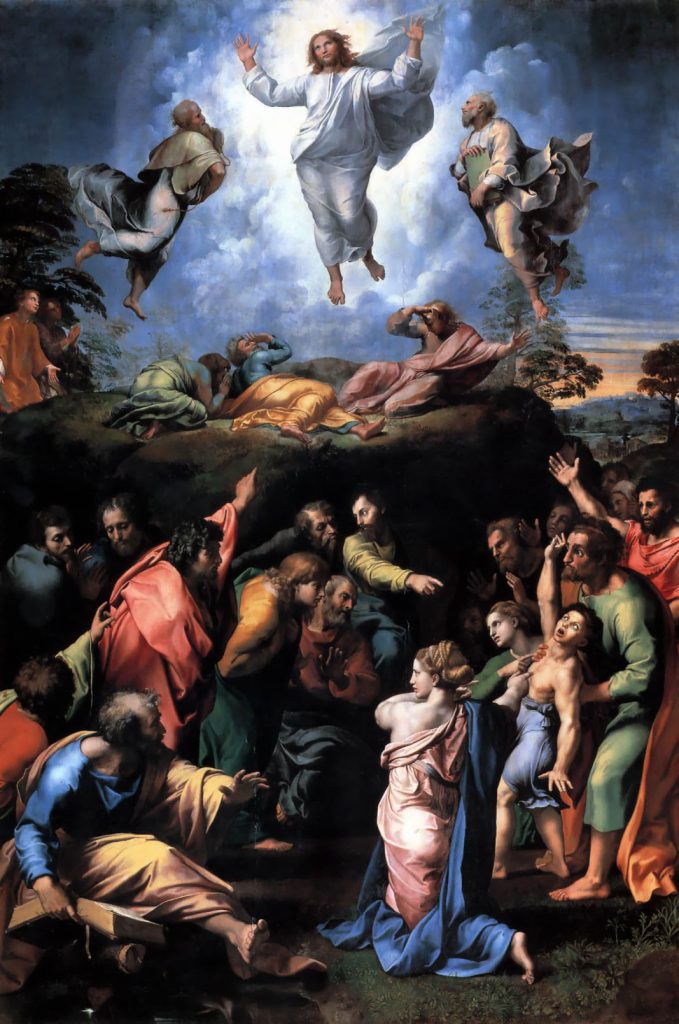 Preachers often focus on Peter’s unthinking outburst offering to make three dwellings for Jesus, Elijah, and Moses on the mountain of the Transfiguration. Such booths would concretize his all-to-human desire to experience continually the radiance of God. Life, however, is not like that; it’s not all mountaintop highs. Life is full of ups and downs, both high mountaintops and low valleys.
Preachers often focus on Peter’s unthinking outburst offering to make three dwellings for Jesus, Elijah, and Moses on the mountain of the Transfiguration. Such booths would concretize his all-to-human desire to experience continually the radiance of God. Life, however, is not like that; it’s not all mountaintop highs. Life is full of ups and downs, both high mountaintops and low valleys.
 On Palm Sunday, I suggested that we think of Holy Week and Easter as a three-act drama beginning with an Overture on Palm Sunday. Last night, we took part in the first act. The analogy of the Three Holy Days (or “Triduum”) to a play breaks down if we think of ourselves as the “audience.” We are not the audience.
On Palm Sunday, I suggested that we think of Holy Week and Easter as a three-act drama beginning with an Overture on Palm Sunday. Last night, we took part in the first act. The analogy of the Three Holy Days (or “Triduum”) to a play breaks down if we think of ourselves as the “audience.” We are not the audience.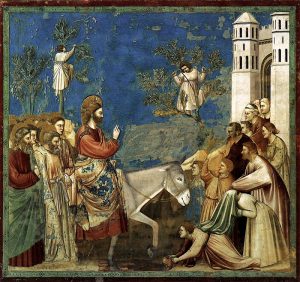 Redemption is a drama in three acts – three acts and a brief intermission – today the prelude, the overture, an introduction encapsulating the story to be fleshed out as the action proceeds. Jesus and his companions enter the city of Jerusalem from the east while the Roman governor, Pilate, makes his annual procession into the city in pomp and circumstance from the west.
Redemption is a drama in three acts – three acts and a brief intermission – today the prelude, the overture, an introduction encapsulating the story to be fleshed out as the action proceeds. Jesus and his companions enter the city of Jerusalem from the east while the Roman governor, Pilate, makes his annual procession into the city in pomp and circumstance from the west.  When I was child in my tween years, I spent a lot of time at the Public Library checking out stacks of books, with that wonderful musty library smell, to read under the big oak tree in our back yard on hot summer days. As I was a U.S. history buff both then and now, I gravitated toward a series of children’s books whose titles began with the phrase – “we were there”. For example, We Were There at Lexington and Concord, We Were There at Battle of Gettysburg and my favorite – We Were There at Pearl Harbor. The books had the same two characters – a boy and a girl around my age at the time, who happened to be living right in the middle of these key historic events. They often performed semi-heroic acts and were usually honored or congratulated by some famous person at the end of the book.
When I was child in my tween years, I spent a lot of time at the Public Library checking out stacks of books, with that wonderful musty library smell, to read under the big oak tree in our back yard on hot summer days. As I was a U.S. history buff both then and now, I gravitated toward a series of children’s books whose titles began with the phrase – “we were there”. For example, We Were There at Lexington and Concord, We Were There at Battle of Gettysburg and my favorite – We Were There at Pearl Harbor. The books had the same two characters – a boy and a girl around my age at the time, who happened to be living right in the middle of these key historic events. They often performed semi-heroic acts and were usually honored or congratulated by some famous person at the end of the book.  The First Sunday in Lent … that’s today. That means we get the story of Jesus being chased into the desert by the Holy Spirit after his baptism by John in the River Jordan, the story of Jesus being accosted in the desert by the Tempter (whom Matthew in our Gospel text today also names “the devil” – in Greek the word is diabolos meaning “accuser”), the story of Jesus refusing to give into the three temptations. We always get some version of this story on the First Sunday in Lent. And this year the Lectionary gives us a double-whammy of temptation by linking that familiar gospel tale with the equally family story of Eve and the serpent and the fruit of the tree of the knowledge of good and evil, the so-called “apple.”
The First Sunday in Lent … that’s today. That means we get the story of Jesus being chased into the desert by the Holy Spirit after his baptism by John in the River Jordan, the story of Jesus being accosted in the desert by the Tempter (whom Matthew in our Gospel text today also names “the devil” – in Greek the word is diabolos meaning “accuser”), the story of Jesus refusing to give into the three temptations. We always get some version of this story on the First Sunday in Lent. And this year the Lectionary gives us a double-whammy of temptation by linking that familiar gospel tale with the equally family story of Eve and the serpent and the fruit of the tree of the knowledge of good and evil, the so-called “apple.”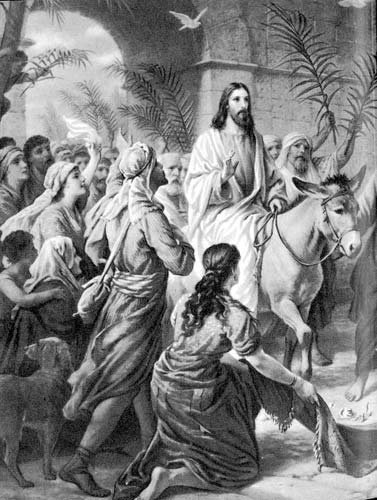 What is Jesus up to? Why is he doing this?
What is Jesus up to? Why is he doing this?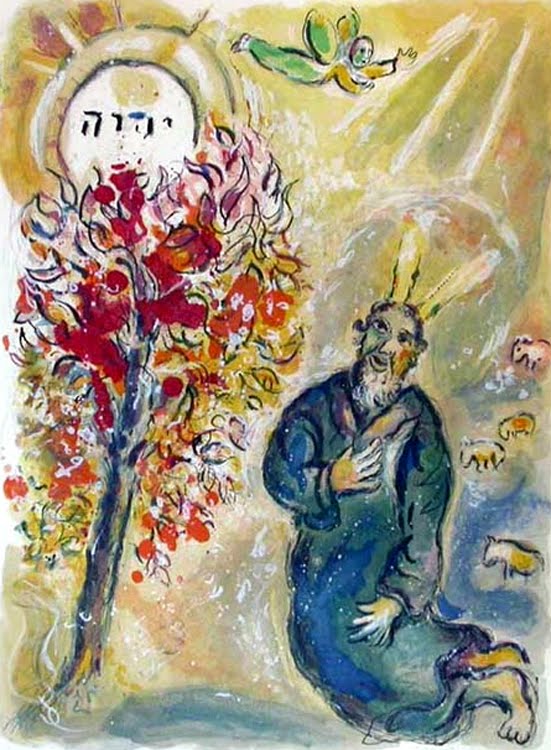
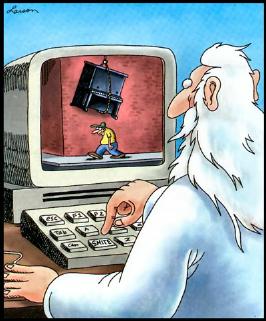 Some years ago the cartoonist Gary Larson published a cartoon of an old white-bearded judgmental God sitting at his computer terminal watching the live-streaming video of some feckless and unsuspecting sinner walk under a piano suspended from a crane while God’s finger is poised over a button on the keyboard labeled “Smite”. This seems to be the God these folk are describing to Jesus, a bookkeeper god who keeps a running tally of the good things and bad things we may do and then at some arbitrary point pushes the “Smite” button and puts paid to our cosmic account. This is the god of those who ask “Why me? What have I done to deserve this?” when something bad happens to them. This is the god of those who say “Everything happens for a reason” when something bad happens to someone else. This is the picture of God that Jesus rejects utterly and completely.
Some years ago the cartoonist Gary Larson published a cartoon of an old white-bearded judgmental God sitting at his computer terminal watching the live-streaming video of some feckless and unsuspecting sinner walk under a piano suspended from a crane while God’s finger is poised over a button on the keyboard labeled “Smite”. This seems to be the God these folk are describing to Jesus, a bookkeeper god who keeps a running tally of the good things and bad things we may do and then at some arbitrary point pushes the “Smite” button and puts paid to our cosmic account. This is the god of those who ask “Why me? What have I done to deserve this?” when something bad happens to them. This is the god of those who say “Everything happens for a reason” when something bad happens to someone else. This is the picture of God that Jesus rejects utterly and completely.

